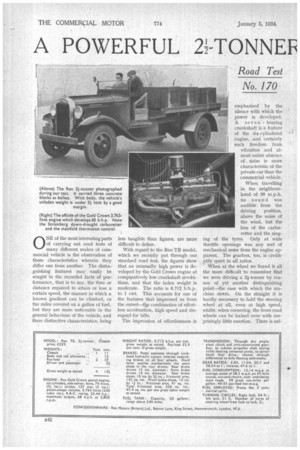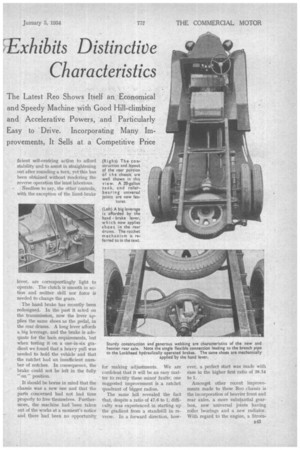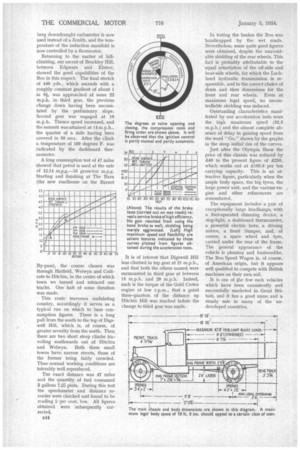A POWERFUL Z-TONNEF
Page 56

Page 57

Page 58

If you've noticed an error in this article please click here to report it so we can fix it.
Exhibits Distinctive
Road Test
Characteristics
No. 170
ONE of the most interesting parts of carrying out road tests of many different makes of commercial vehicle is the observation of those characteristics wherein they differ one from another. The distinguishing features may easily be sought in the recorded facts of performance, that is to say, the time or distance required to attain or lose a certain speed, the manner in which a . known gradient can be climbed, or the miles covered on a gallon of fuel, but they are more noticeable in the general behaviour of the vehicle, and these distinctive characteristics, being
less tangible than figures, are more difficult to define.
With regard to the Reo TB model, which we recently put through our standard road test, the figures show that an unusually high power is developed by the Gold Crown engine at comparatively low crankshaft revolutions, and that the laden weight is moderate. The ratio is 0.712 b.h.p. to 1 cwt. This accounts for one of the features that impressed us from the outset—t combination of effortless acceleration, high speed and disregard for hills The impression of effortlessness is emphasized by the silence with which the power is developed. A seven bearing crankshaft is a feature of the six-cylindered engine, and certainly such freedom from vibration and almost entire absence of noise is more characteristic of the private car than the commercial vehicle.
When travelling in the neighbourhood of 30 m.p.h. no sound was audible from the driving position, above the noise of the wind, but the hiss of the carburetter and the singing of the tyres. Only at wide throttle openings was any sort of mechanical noise from the engine apparent. The gearbox, too, is creditably quiet in all ratios.
When at the wheel we found it all the more difficult to remember that we were driving a 2i-tormer by reason of yet another distinguishing pointL—the ease with which the machine steers. On the straight it is hardly necessary to hold the steering wheel at all, even at high speed, whilst, when cornering, the front road wheels can be locked over with surprisingly little exertion. There is suf ficient self-centring action to afford stability and to assist in straightening out after rounding a turn, yet this has been obtained without rendering the reverse operation the least laborious.
Needless to say, the other controls, with the exception of the hand-brake lever, are correspondingly light to operate. The clutch is smooth in action and neither skill nor force is needed to change the gears.
The hand brake has recently been redesigned. In the past it acted on the transmission, now the lever applies the same shoes as the pedal, in the rear drums. A long lever affords a big leverage, and the brake is adequate for the bare requirements, but when testing it on a one-in-six gradient we found that a heavy pull was needed to hold the vehicle and that the ratchet had an insufficient number of notches. In consequence, the brake could not be left in the fully " on " position.
It should be borne in mind that the chassis was a new one and that the parts concerned had not had time properly to free themselves. Furthermore, the machine had been taken out of the works at a moment's notice and there had been no opportunity
for making adjustments. We are confident that it will be an easy matter to rectify these minor faults; one suggested improvement is a ratchet quadrant of bigger radius.
The same hill revealed the fact that, despite a ratio of 47.6 to 1, difficulty was experienced in starting up the gradient from a standstill in reverse. In a forward direction, how
ever, a perfect start was made with ease in the higher first ratio of 38.54 tot.
Amongst other recent improvements made to these Reo chassis is the incorporation of heavier front and rear axles, a more substantial gearbox, new universal joints having roller bearings and a new radiator. With regard to the engine, a Strom berg downdraught carburetter is now used instead of a Zenith, and the temperature of the induction manifold is now controlled by a thermostat.
Returning to the matter of hillclimbing, our ascent of Brockley Hill, between Edgware and Eistree, showed the good capabilities of the Reo in this respect. The final stretch of 440 yds., which ascends with a roughly constant gradient of about 1 in 8, was approached at some 22 m.p.h. in third gear, the previous change down having been necessitated by the preliminary slope. Second gear was engaged at 10 m.p.h. Thence speed increased, and the summit was attained at 14 m.p.h., the quarter of a mile having been covered in 50 secs. After the climb a temperature of 160 degrees F. was indicated by the dashboard thermometer.
A long consumption test of 47 miles showed that petrol is used at the rate of 12.14 m.p.g.-58 gross-ton m.p.g. Starting and finishing at The Barn (the new roadhouse on the Barnet By-pass), the course chosen was through Hatfield, Welwyn and Codicote to Hitchin, in the centre of which town we turned and retraced our tracks. One halt of some duration was made.
This route traverses undulating country, accordingly it serves as a typical run on which to base consumption figures. There is a long pull from the south to the top of Digswell Hill, which is, of course, of greater severity from the north. Then there are two short steep climbs travelling southwards out of Hitchin and Welwyn. Both these small towns have narrow streets, those of the former being fairly crowded. Thus normal working conditions are tolerably well reproduced.
The exact distance was 47 miles and the quantity of fuel consumed 3 gallons 7.2$ pints. During this test the speedometer and distance recorder were checked and found to be reading 5 per cent. low. All figures obtained were -subsequently corrected. It is of interest -that Digswell Hill was climbed in top gear at 21 m.p.h., and that both the others named were surmounted in third gear at between 15 m.p.h. and 20 m.p.h. Indeed, such is the torque of the Gold Crown engine at low r.p.m., that a point three-quarters of the distance up Hitchin Hill was reached before the change to third gear was made.
In testing the brakes the Reo was 'handicapped by the wet roads. Nevertheless, some quite good figures were obtained, despite the unavoidable skidding of the rear wheels. This fact is probably attributable to the equal retardation of the off-side and hear-side wheels, for which the Lockheed hydraulic transmission is responsible, and to the correct choke of drum and shoe dimensions for the front and rear wheels. Even at maximum legal speed, no uncontrollable skidding was induced.
Outstanding characteristics mani: fested by our acceleration tests were the high maximum speed (52.5 m.p.h.) and the almost complete absence of delay in gaining speed from the word "Go," shown by the graphs in the steep initial rise of the curves.
Just after the Olympia Show the price of this chassis was reduced by £40 to the present figure of £259, which works out at 2103.6 per ton carrying capacity. This is an attractive figure, particularly when the ample body space, the big tyres, the large power unit, and the various .en, gine and other refinements are remembered.
The equipment includes a pair of exceptionally large headlamps, with a foot-operated dimming device, a stop-light, a dashboard thermometer, a powerful electric horn, a driving mirror, a front bhmper, and, of course, a spare wheel and tyre, carried under the rear of the frame. The general appearance a the vehicle is pleasing and businesslike. The Rea Speed Wagon is, of course, of American origin, but it appears well qualified to compete with British machines on their own soil.
It is one of the few such vehicles which have been consistently and successfully marketed in Great Britain, and it has a good name and a steady sale in many of the undeveloped countries.




























































































